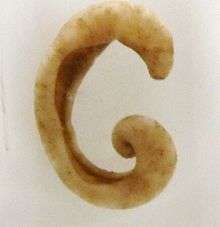Solenogastres
The Solenogastres (less often referred to as Neomeniomorpha), common name the solenogasters, are one subclass of small, worm-like, shell-less molluscs (Aplacophora), the other subclass being the Caudofoveata (Chaetodermomorpha).
| Solenogastres | |
|---|---|
 | |
| A preserved specimen of Epimenia verrucosa | |
| Scientific classification | |
| Kingdom: | Animalia |
| Phylum: | Mollusca |
| Class: | Aplacophora |
| Subclass: | Solenogastres |
| Orders | |
Some recent literature, and recent molecular evidence, indicates that the Aplacophora may be polyphyletic, and therefore these taxonomists divide Solenogastres and Caudofoveata into separate classes.[1]
Morphology
In contrast to all other molluscan classes, the Aplacophora have no shell, and are instead covered by aragonitic sclerites (calcareous spicules), which can be solid or hollow. These spicules can be arranged perpendicular to one another within the cuticle to form a skeleton, or can stick up to form a palisade, or can lie flat against the cuticle.[2]
80% of solenogaster species have a radula, while in others it is secondarily lost. The radula may bear one or more teeth per row; where there is more than one tooth, there is no central radular tooth.[2] The radula grows by dividing existing teeth in two, or by adding a new tooth at the centre of the radular row.[2] The salivary glands are very elaborate, and are an important character for taxonomy. Next to the mouth they have a unique sense organ, the vestibulum.
The solenogastres do not have true ctenidia, although their gill-like structures resemble them.[3]
Development
During development many Solenogastres are covered by a spiny scleritome comprising spines or scale-like plates; this has been likened to the halwaxiid scleritome.[4]
Sclerites of Epimenia start out solid before developing a hollow stem that subsequently solidifies.[5]
Ecology
Phylogeny
There is some uncertainty regarding the phylogenetic position of the solenogasters. Traditionally considered to be the most basal molluscan group and the sister group to the Caudofoveata, alternatives to both of these statements have been proposed on various lines of evidence.[4] Indeed, some molecular datasets plot Solenogastres as an outgroup to Mollusca.[8]
References
- e.g. Todt, C., Okusu, A., Schander, C. & Schwabe, E. (2008). "Solenogastres, Caudofoveata and Polyplacophora.". In Ponder, W. & Lindberg D. (ed.). Phylogeny and Evolution of the Mollusca. University of California Press. ISBN 978-0-520-25092-5.CS1 maint: multiple names: authors list (link)
- Scheltema, A. H. (1999). "Two solenogaster molluscs, Ocheyoherpia trachia n.sp. From Macquarie Island and Tegulaherpia tasmanica Salvini-Plawen from Bass Strait (Aplacophora: Neomeniomorpha)". Records of the Australian Museum. 51: 23–31. doi:10.3853/j.0067-1975.51.1999.1266.
- Wilbur, Karl M.; Trueman, E.R.; Clarke, M.R., eds. (1985), "2. Early evolution and the Primitive Groups", The Mollusca, 10. Evolution, New York: Academic Press, ISBN 0-12-728702-7
- Todt, C.; Wanninger, A. (2010). "Of tests, trochs, shells, and spicules: Development of the basal mollusk Wirenia argentea (Solenogastres) and its bearing on the evolution of trochozoan larval key features". Frontiers in Zoology. 7 (1): 6. doi:10.1186/1742-9994-7-6. PMC 2828982. PMID 20181015.
- Okusu, A. (2002). "Embryogenesis and development of Epimenia babai (Mollusca: Neomeniomorpha)". The Biological Bulletin. 203 (1): 87–103. doi:10.2307/1543461. JSTOR 1543461. PMID 12200259.
- Guralnick, R.; Smith, K. (1999). "Historical and biomechanical analysis of integration and dissociation in molluscan feeding, with special emphasis on the true limpets (Patellogastropoda: Gastropoda)". Journal of Morphology. 241 (2): 175–195. doi:10.1002/(SICI)1097-4687(199908)241:2<175::AID-JMOR7>3.0.CO;2-0. PMID 10420163.
- Scheltema, A. H.; Jebb, M. (1994). "Natural history of a solenogaster mollusc from Papua New Guinea,Epimenia australis(Thiele) (Aplacophora: Neomeniomorpha)". Journal of Natural History. 28 (6): 1297. doi:10.1080/00222939400770661.
- Wilson, N.; Rouse, G.; Giribet, G. (2010). "Assessing the molluscan hypothesis Serialia (Monoplacophora+Polyplacophora) using novel molecular data". Molecular Phylogenetics & Evolution. 54 (1): 187–193. doi:10.1016/j.ympev.2009.07.028. PMID 19647088.
Further reading
- Meyer, Achim; Todt, Christiane; Mikkelsen, Nina T.; Lieb, Bernhard (2010). "Fast evolving 18S rRNA sequences from Solenogastres (Mollusca) resist standard PCR amplification and give new insights into mollusk substitution rate heterogeneity". BMC Evolutionary Biology. 10: 70. doi:10.1186/1471-2148-10-70. PMC 2841657. PMID 20214780.